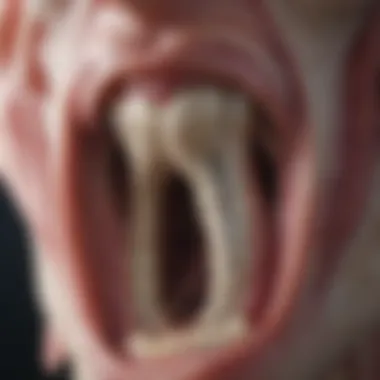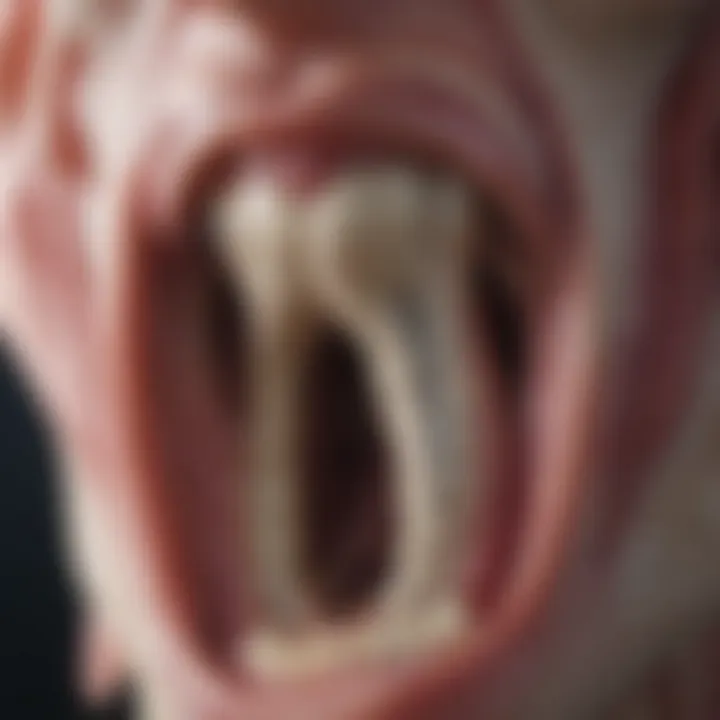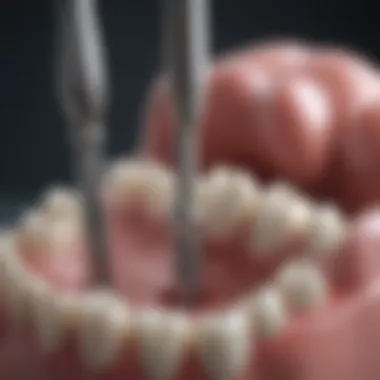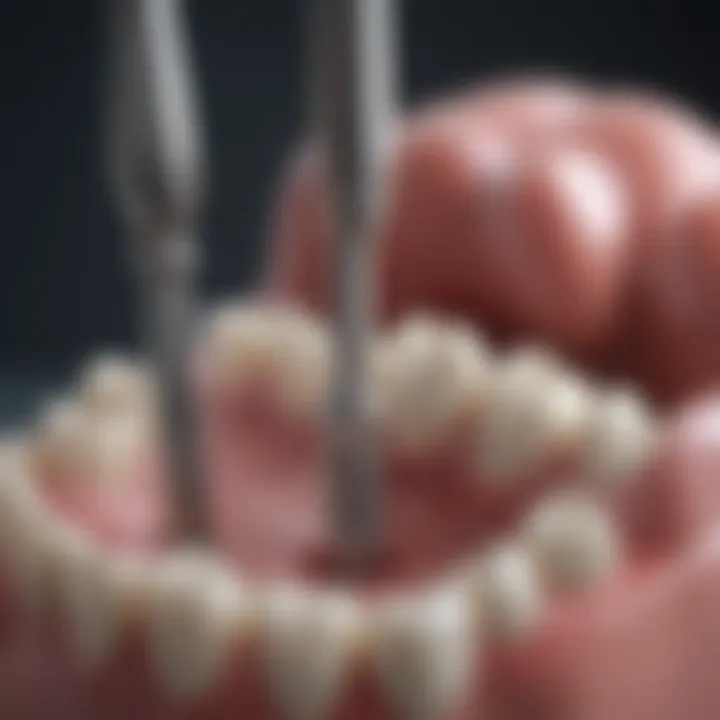Tooth Drainage: Understanding Dental Health & Procedures


Intro
Tooth drainage is a critical yet often overlooked aspect of dental health. Understanding how drainage functions and the implications of improper management can significantly affect both treatment outcomes and overall oral health. This article aims to shed light on the biological mechanisms responsible for tooth drainage, the symptoms of infections, and the various clinical procedures used to address these issues. We will also explore contemporary diagnostic methods and treatment options, providing a framework for dental professionals and enthusiasts alike.
Methodology
Overview of Research Methods Used
Research for this article involved a comprehensive review of existing literature related to dental infections, abscess pathways, and treatment modalities. The focus was on peer-reviewed articles, clinical guidelines, and case studies that highlight the importance of efficient drainage techniques. Interviews with dental practitioners also provided valuable insights into current practices and challenges in managing tooth drainage.
Data Collection Techniques
Data was collected using several techniques:
- Literature Review: A thorough analysis of published research articles helped outline the core biological mechanisms and procedural techniques related to tooth drainage.
- Interviews: Conversations with dental professionals illuminated practical applications and real-world scenarios encountered in dentistry.
- Case Studies: Analyzing documented cases allowed for a better understanding of various treatment outcomes.
Understanding Tooth Drainage
Tooth drainage involves the expulsion of pus formed due to abscesses or infections within the dental and periodontal areas. Proper drainage is essential for alleviating pain and preventing the spread of infection. Common symptoms that indicate a need for drainage include swelling, sensitivity to touch or temperature, and persistent pain.
Causes and Symptoms of Tooth Drainage
Infections can arise from various sources including:
- Untreated Cavities: Bacteria invade the tooth structure, leading to pulp infection.
- Gum Disease: Inflammation of gums can progress to abscess formation due to bacterial colonization.
- Trauma: Physical injuries can expose the tooth pulp to pathogens, resulting in infection.
Symptoms may vary but typically include:
- Persistent localized pain
- Swelling around the affected tooth
- Discoloration of the tooth
Diagnostic Approaches
Dental professionals use various diagnostic techniques to determine the necessity for drainage. Standard x-rays help visualize infection spread, while clinical examinations focus on signs of swelling and tenderness. Advanced imaging techniques like a Cone Beam CT might be employed for more complex cases.
Treatment Options Available
When managing tooth drainage, several treatment options are available:
- Endodontic Treatment: Typically performed in cases of pulp infection, this procedure aims to clean the root canal.
- Incision and Drainage: A surgical approach to directly remove pus and alleviate pressure.
- Antibiotics: Prescription antibiotics may be necessary to combat systemic infections.
Properly addressing tooth drainage can prevent more serious complications such as osteomyelitis or systemic infection.
Future Directions
Upcoming Trends in Research
Future studies should focus on the development of less invasive techniques for managing dental infections. Advances in biomaterials may also enhance the effectiveness of drainage procedures.
Areas Requiring Further Investigation
There is a pressing need to explore the relationship between systemic health conditions and dental drainage. Understanding how these factors interplay can refine treatment protocols and enhance patient outcomes.
Preface to Tooth Drainage
Understanding tooth drainage is crucial for maintaining overall dental health. Tooth drainage involves the process of removing or alleviating the collection of pus or infected fluid within the tooth or surrounding structures. Dental infections, if left untreated, can lead to severe complications, including systemic health issues. Therefore, recognizing the significance of effective tooth drainage is essential for both dental professionals and patients.
Definition and Importance
Tooth drainage refers to the process of expelling infected materials from the tooth or periodontal region. This is typically associated with dental abscesses, which can develop when bacteria invade the dental pulp or surrounding gum tissues. The importance of drainage lies in its role in preventing the spread of infection and preserving the integrity of adjacent teeth and tissues.


Better tooth drainage not only alleviates pain but also enhances the efficacy of subsequent treatments. Recognizing signs, such as swelling or sensitivity, can prompt timely intervention. This underscores the value of educating patients about the symptoms and consequences of untreated dental issues, emphasizing the need for professional evaluation.
Anatomy of the Tooth
In order to understand tooth drainage, one must first appreciate the anatomy involved. A tooth consists of several parts:
- Enamel: The hard outer layer that protects the tooth.
- Dentin: Beneath the enamel, providing support and containing nerve endings.
- Pulp: The central portion filled with nerves and blood vessels, essential for tooth vitality.
- Periodontal Ligament: Connects the tooth to the jawbone, supporting the tooth structure.
Infections often originate in the pulp, leading to inflammation and pus formation. The understanding of these anatomical elements is vital for professionals when diagnosing and developing effective treatment plans for tooth drainage issues.
Understanding Tooth Drainage Mechanisms
Understanding tooth drainage mechanisms is crucial for comprehending how dental health and treatment procedures operate. This section elaborates on the physiological and pathological aspects that influence tooth drainage, emphasizing their impact on diagnosis and treatment outcomes. Delving into these mechanisms reveals the delicate balance within oral health, where proper drainage can prevent complications and guide clinicians in effective management.
Physiological Processes
Tooth drainage refers to the body's natural ability to manage fluids and prevent infections within dental structures. This process begins with the pulp, which houses nerves and blood vessels, playing a significant role in signaling the body to react to infection or inflammation. The lymphatic system also serves an integral part in this drainage by acting as a filter for pathogens. More specifically, the physiological processes include:
- Pulpal Blood Flow: This flow is essential for delivering nutrients and carrying waste products away, aiding in the maintenance of dental health.
- Lymphatic Drainage: This mechanism helps in removing excess fluids and cellular debris, which is vital for preventing abscess development.
By understanding these processes, dental professionals can better assess the health of a tooth and foresee possible complications.
Pathological Conditions
Pathological conditions, such as periapical and periodontal abscesses, disrupt these mechanisms and can lead to severe dental issues. Recognizing these conditions enables healthcare providers to evaluate risk factors and implement appropriate treatment plans, ensuring improved patient outcomes.
Periapical Abscess
A periapical abscess arises from infection at the tip of the tooth's root, essentially caused by untreated dental caries or trauma. This condition is characterized by:
- Local Pain and Swelling: Pain is often intense and localized, signaling the body’s inflammatory response.
- Pus Formation: This signifies the body's attempt to fight the infection.
The significance of periapical abscesses in this article lies in their commonality and the direct impact they have on overall dental health. They are often a pivotal point in dental education due to their prevalence among patients. An advantage of highlighting periapical abscesses is their straightforward diagnosis through clinical evaluation and radiographic analysis.
Periodontal Abscess
In contrast, a periodontal abscess originates in the supporting tissues around a tooth, usually linked to periodontal disease. The characteristics of a periodontal abscess include:
- Pocket Depth Increase: This provides a space for bacteria to thrive, exacerbating the condition.
- Gingival Inflammation: As the infection progresses, inflammation is evident, impacting soft tissue health.
The relevance of periodontal abscesses in the narrative centers around their role in systemic health. Chronic periodontal diseases have connections to conditions such as heart disease and diabetes. By discussing this, the article not only addresses localized infections but also underscores their broader implications on health. An added complexity is the treatment options, which can range from conservative management to surgical interventions, depending on the severity of the case.
In summary, understanding both physiological and pathological mechanisms of tooth drainage equips healthcare professionals with essential insights into dental health, diagnosis, and treatment strategies. This foundational knowledge is valuable for enhancing clinical practice and optimizing patient care.
Clinical Significance of Tooth Drainage
The significance of tooth drainage in dental health cannot be overstated. This section examines the essential role it plays in maintaining oral hygiene and preventing systemic complications. Issues related to tooth drainage are not merely localized; they can ripple throughout the entire body. Understanding this significance is crucial for both dental professionals and patients alike.
Impact on Overall Health
Tooth drainage directly impacts overall health in various ways. When an infection in the tooth is not properly drained, it can lead to more severe complications. For example, the bacteria from a dental abscess may enter the bloodstream, potentially resulting in conditions like endocarditis, which is an infection of the heart lining. Pain and discomfort are not the only concerns; compromised tooth drainage can lead to systemic health issues that extend beyond the mouth.
Several studies indicate links between poor oral health and chronic diseases. Conditions such as diabetes, cardiovascular disease, and respiratory disease can be exacerbated by untreated dental infections. Maintaining proper tooth drainage helps to manage infection, thereby reducing the likelihood of these systemic issues. Regular dental check-ups are necessary to catch any drainage issues early, allowing for timely treatment, thereby protecting overall health.
"Good dental health is the key to good health overall. Ignoring issues like tooth drainage can have serious repercussions."
Connection to Systemic Diseases
There is a growing body of research suggesting that dental health is interconnected with systemic health. Poor tooth drainage may not only signify local infection but also a warning sign for conditions that affect the whole body. For instance, periodontal diseases have been closely linked with heart diseases. Inflammation from dental infections can contribute to chronic inflammation throughout the body, which is a known risk factor for various systemic diseases.
Moreover, the presence of certain pathogens in the oral cavity can correlate with conditions like Alzheimer's and other neurodegenerative diseases. Inflammatory responses to tooth infections may impact cognitive function over time.


Here are a few key diseases associated with compromised tooth drainage:
- Diabetes: Poor oral health can hinder blood sugar control, and infections can worsen diabetes.
- Cardiovascular Diseases: Bacteria from dental infections can travel to the heart, increasing the risk of heart attack or stroke.
- Respiratory Diseases: Inhalation of bacteria from the oral cavity can lead to pneumonia and other respiratory tract infections.
In summary, the clinical significance of tooth drainage extends far beyond the oral cavity. It embodies a crucial component of overall health, making awareness and proactive management imperative for preventing serious complications.
Diagnosis of Tooth Drainage Issues
Diagnosing tooth drainage issues is critical for effective dental management. Prompt identification of underlying problems can help in preventing complications. This section explores various methods used to diagnose these conditions, emphasizing the role of comprehensive clinical evaluation and advanced imaging techniques.
Clinical Evaluation Techniques
Clinical evaluation is the first step in diagnosing tooth drainage issues. It involves a systematic approach to gather information about the patient’s symptoms, medical history, and physical examination of the oral cavity. Dentists assess pain levels, swelling, and any visible signs of infection, such as abscesses. The health professional may use percussion testing to check for tenderness around specific teeth, as this can indicate a deeper issue.
Clinical evaluations may also include the use of diagnostic tools like the periodontal probe to assess gum health and identify possible drainage pathways. Additionally, assessing patient’s overall health condition provides context to the dental issues, potentially revealing links to systemic diseases.
Imaging Studies
Imaging studies play an essential role in the diagnosis of tooth drainage issues as they provide visual insights that cannot be obtained through clinical evaluation alone. The two main imaging techniques used are radiographic analysis and 3D imaging, each offering distinct advantages.
Radiographic Analysis
Radiographic analysis, commonly known as X-rays, is a widely used method in dentistry. This imaging technique helps in detecting underlying infections, abscess formations, and bone loss around the affected teeth. One key characteristic of radiographic analysis is its ability to show variances in density that indicate decay or infection before they become clinically apparent.
Radiographs are often considered a standard of care in diagnosing dental conditions.
Despite its popularity, radiographic analysis has limitations. It provides a two-dimensional view of a three-dimensional structure, which may lead to misinterpretation in complex cases. Furthermore, the interpretation requires significant expertise to avoid overlooking subtle signs of drainage issues.
3D Imaging
3D imaging has emerged as an innovative technique that provides a detailed view of dental structures. This imaging modality is invaluable for diagnosing complex conditions that may not be visible through traditional radiographic methods. One notable feature of 3D imaging is its capacity to create volumetric reconstructions of dental anatomy, allowing for precise localization of infections and determining the extent of any abscesses.
3D imaging has gained popularity due to its ability to enhance the diagnostic process and improve treatment planning. However, it requires specialized equipment and training, which might limit its accessibility in some dental practices. Additionally, the cost associated with 3D imaging can be a barrier for patients without dental insurance.
Treatment Options for Tooth Drainage Problems
Tooth drainage problems often stem from infections or abscesses that can severely impact dental health. Addressing these issues is crucial not only for alleviating pain but also for preventing further complications. Treatment options can be broadly categorized into conservative management and surgical interventions. Each approach has its own advantages and disadvantages, which will each have a significant role in patient management.
Conservative Management
Antibiotic Therapy
Antibiotic therapy is frequently one of the first approaches to treating tooth drainage issues. This method involves prescribing antibiotics to combat the bacterial infections that lead to abscess formations. One of the key characteristics of antibiotic therapy is its ability to target the specific bacteria causing the infection, often reducing inflammation and pain.
Its popularity in dental practices arises from its non-invasive nature, allowing for treatment before resorting to surgery. However, a unique feature of antibiotic therapy is that it does not replace the need for definitive dental procedures, such as drainage. While the advantages include the reduction of symptoms and prevention of further infections, there are disadvantages, such as potential antibiotic resistance if overused.
Palliative Care
Palliative care plays a supportive role in the management of tooth drainage issues. This approach focuses on pain management and quality of life for affected patients. One of its primary characteristics is that it addresses the symptoms rather than the underlying cause. Palliative care is often used in conjunction with other treatments, providing relief from acute pain while other definitive treatments are planned or executed.
This strategy is beneficial because it prioritizes patient comfort. However, it has the limitation of not addressing the infection directly, which must be mitigated through other means eventually.
Surgical Interventions
Incision and Drainage
Incision and drainage is a direct surgical approach to managing abscesses associated with tooth drainage. This procedure involves making a small incision in the abscess to allow purulent material to escape. This method is characterized by its immediacy in providing relief from swelling and pressure in the affected area. It is a commonly chosen method due to the speed with which it alleviates symptoms.
Though effective, it carries risks such as infection and the need for follow-up care. The immediate relief it offers can sometimes be a significant advantage, especially in cases of acute abscesses. However, if the underlying cause is not addressed, further interventions may be required.


Root Canal Treatment
Root canal treatment is another surgical option for addressing tooth drainage issues, particularly when the pulp of the tooth is infected. This procedure involves removing the infected pulp, cleaning the interior of the tooth, and sealing it to prevent reinfection. The key characteristic of root canal treatment is its potential to save the natural tooth, which is beneficial for long-term oral health.
A unique aspect of this procedure is the use of advanced technology, such as 3D imaging, to guide the treatment. This allows for a precise approach, reducing the risk of complications. However, it is more invasive than antibiotics or palliative care and may still require additional visits for follow-up care.
Extraction Procedures
Extraction is often the last resort when other treatment options fail or if the damage to the tooth is extensive. This procedure involves the complete removal of the affected tooth. The key characteristic of extraction is that it provides a permanent solution. In cases where restoration of function is not feasible, extraction can be considered beneficial.
The unique feature of extraction is its immediacy; the problem is resolved relatively quickly. However, patients should be aware of the disadvantages, including the potential for affecting adjacent teeth and the need for replacement options, such as implants or bridges, later on.
In summary, treatment options for tooth drainage problems vary widely in terms of approach, effectiveness, and outcomes. Dental professionals must evaluate the best method based on individual patient needs.
Post-Treatment Care and Considerations
Effective post-treatment care is crucial following dental procedures related to tooth drainage. It ensures not only the success of the treatment, but also promotes optimal healing and prevents complications. Various components shape this phase, including monitoring, follow-up, and patient education. Each element plays a role in reinforcing the treatment's effects and aiding in the overall recovery process.
Monitoring and Follow-Up
Regular monitoring after tooth drainage procedures is essential. Patients must understand their recovery trajectory and maintain communication with their dental care providers. Monitoring may include:
- Symptom Observation: Patients should track any changes in symptoms, such as pain, swelling, or signs of infection.
- Scheduled Appointments: Follow-up visits are vital. Dentists evaluate healing progress and address any concerns that may arise.
- Diagnostic Tools: In some cases, imaging studies may be necessary to ensure that drainage is effectively resolving the issue.
This vigilant approach can greatly reduce the risk of complications and ensure that any recurring issues are dealt with promptly.
"Post-treatment monitoring is like a compass that helps navigate the recovery process. It provides direction and reassurance."
Patient Education
The education of patients is another critical aspect in post-treatment care. Understanding the process can empower patients and foster cooperation, leading to better outcomes. Key areas of patient education include:
- Aftercare Instructions: Clear guidelines should be provided on how to care for treated areas, including dietary restrictions and oral hygiene practices.
- Recognizing Signs of Complication: Patients should be informed about symptoms that require immediate attention, such as increased pain or fever.
- Importance of Oral Hygiene: Educating patients about maintaining good oral hygiene practices post-procedure can prevent further complications, such as infections.
Recent Advances in Tooth Drainage Techniques
Recent advancements in tooth drainage techniques illustrate the ongoing evolution in dental practices. These innovations are essential as they enhance the efficacy of treatment methods, minimize patient discomfort, and improve overall health outcomes. A reflection on these methods deepens our comprehension of dental care and emphasizes the need for continuous adaptation in response to emerging scientific discoveries.
Innovative Technologies in Dentistry
Innovative technologies play a crucial role in managing tooth drainage issues. For instance, laser-assisted therapy has emerged as a game-changer for endodontic procedures. The precision of lasers allows for effective decontamination of root canals, leading to a higher success rate in treatments like root canals. Additionally, ultrasonic instrumentation is gaining popularity for its ability to enhance the cleaning process in complex tooth geometries.
Furthermore, advancements in digital imaging, such as cone-beam computed tomography (CBCT), allow for more detailed understanding of tooth anatomy. This improved visibility aids clinicians in identifying drainage pathways and preparing appropriate treatments.
- Enhanced Accuracy: New imaging methods provide detailed visuals for better diagnosis.
- Patient Comfort: Less invasive techniques reduce discomfort during procedures.
- Improved Outcomes: Technologies such as lasers lead to higher rates of successful treatments.
Research and Future Directions
Current research in tooth drainage goes beyond procedure efficiency; it also looks into biomaterials and regenerative dentistry. The development of bioactive materials holds promise in repairing and regenerating damaged tooth structures. Studies suggest these materials can stimulate natural healing processes, potentially reducing the need for extensive surgical interventions.
Moreover, future directions in this area focus on integrating artificial intelligence and machine learning in diagnostics. By analyzing image data, AI can assist in predicting outcomes of various drainage techniques. This predictive analysis can significantly improve the decision-making process in clinical settings.
"Advancements in dental technology and research are setting the stage for a new era in managing tooth drainage, aligning treatments more closely with patient needs."
In summary, the recent advances in tooth drainage techniques signify a vital shift toward more effective, less invasive dental care. Ongoing research and innovation are essential to improving patient outcomes and ensuring that the practices keep pace with scientific advancement.
Key Takeaways
The significance of this article lies in its comprehensive exploration of tooth drainage. Understanding tooth drainage impacts both dental health and broader systemic health. Through the detailed examination within this article, a few critical elements emerge.
- Summary of Findings: The findings presented illuminate the complex interactions involved in tooth drainage, highlighting the mechanisms, diagnoses, and treatments necessary for effective management of dental infections. Dental professionals gain insight into common conditions such as periapical abscesses, contributing to accurate diagnoses and optimal treatment plans.
- Importance of Continued Research: The field of dental health continually evolves, underscoring the necessity of ongoing research. Innovations in techniques and tools enhance the ability to treat dental infections more effectively. Professionals must remain updated on emerging trends to ensure informed clinical decisions. This aspect amplifies the article's relevance, preserving the reader's understanding of current and future advancements in tooth drainage methods.
Additionally, recognizing how tooth drainage connects with overall health is crucial. Ignoring dental issues can lead to systemic diseases, since oral health is often a window to wider physiological conditions. The insights provided by this article serve as a valuable resource for students, researchers, and practicing professionals alike, demonstrating the critical nature of this topic.
"Understanding the mechanics of tooth drainage is essential not only for maintaining dental health but also for ensuring systemic well-being."
By synthesizing the information, this article aims to empower readers with a deep understanding of tooth drainage, ultimately enhancing patient care and informing best practices in dentistry.







